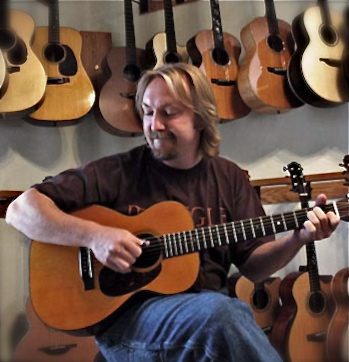Brian Boggs is one of the most highly respected furniture makers in America. Known for his creative passion and attention to detail, Brian now brings his considerable talents to the world of music, giving us the ultimate Guitar Chair!
As soon as I sat in the Guitar Chair I noticed an immediate improvement in my playing posture. Long rehearsals and performances are definitely made easier when you are comfortable. I find that the Guitar Chair lessens back fatigue, and helps break the bad habit of slumping over the guitar. Paul and I both highly recommend the Guitar Chair by Brian Boggs. It is the ultimate guitar accessory!
What makes your guitar chair more appropriate for players than a standard kitchen chair?
What is different about the guitar chair is that the whole chair is designed around how guitar players move, hold their guitar, and position their hands. Beginning with the seat, I sculpted it to support the player comfortably, but it’s round shape and forward slant address the guitarist’s forward lean as well as leg movements. It provides comfort while rocking out on the blues or meditating on a classical number. The rolling downward of the front of the seat allows either knee to drop down or move to the side comfortably. No edges to catch you under the thigh so your legs don’t fall asleep.
The back is narrower and shorter than a typical kitchen chair. It also has a pitch designed for the position of a guitarist in performance. The lower portion of the back is carved back to so that when leaning forward there is still some support in the lumbar area.
A kitchen chair, on the other hand is designed for single position sitting, is tilted slightly backward, and usually has a trapezoidal seat shape. Having said all this about the differences, this design will make a great kitchen chair with a simple change to the pitch. I am working on that version now.
That will depend on just how much is needed to make the accommodation. They will need to call the shop and we will take it from there. If it is simply a wood choice matter, we can do that easily enough. Harder woods for the seat or back will cost more in labor, and the chair price will also have to reflect any additional wood cost if more expensive woods are chosen. Any changes to the design will add cost just because the chair can’t follow the usual well honed process we work with. It will need extra time and attention. That is always done on an individual basis.
Do we have plans to develop any other products especially aimed at musicians and guitarists in particular?
I don’t have new designs up and going right now, but a music stand and drawer unit for music storage are on my mind. We have the craftsmen to build them beautifully. It’s just a matter of getting the designs worked out.
What is the typical wait time for a custom order?
Right now we are looking at about 10 weeks. Production of the chairs is fairly constant. Orders arrive in a more erratic pattern, so our backlog will fluctuate from 4-12 weeks for a while. We will know when we get an order what the delivery time will be on that chair.
Can you tell us more about the mission of your company?
The Boggs Collective represents a new business vision that fosters the highest levels of design, craftsmanship and sustainability in studio furniture making. Our model integrates four key components: materials, workspace, training and visibility creating opportunities for landowners, loggers, sawyers and craftspeople to work collaboratively. With this full cycle collaboration fine craftsmanship, sustainable forest management and our clients’ needs are integrated into a mutually supportive and sustainable partnership.
For landowners, loggers and sawyers who practice sustainable forestry there is an assurance that their efforts are helping create value-added wood products that stimulate the regional economy. For craftspeople involved, it offers an infrastructure that allows woodworkers to focus on their passion. For our clients, it represents the chance to own timeless, handcrafted furniture produced in a reliable and sustainable manner. For all of us, it presents a new way of looking at the items we live with, an awareness of the labor and materials that go into each piece and a conscious choice to hold these values at the heart of our philosophy and practice.
THE BOGGS COLLECTIVE — MISSION
Our Mission – Design and produce exquisite furniture in a reliable and sustainable manner
Our Vision – To provide a model that supports furniture makers and forests sustainably
Our Core values – Excellence – creating conditions that promote our highest level of engagement in all facets of our work.
Innovation – creativity drive development of processes and products designed to support and inspire us.
Integrity – holding our values and beliefs present in both our individual and collective actions and products
Social and Environmental Responsibility – honoring our responsibility to the health and well being of our forests, communities and craftsmen.































